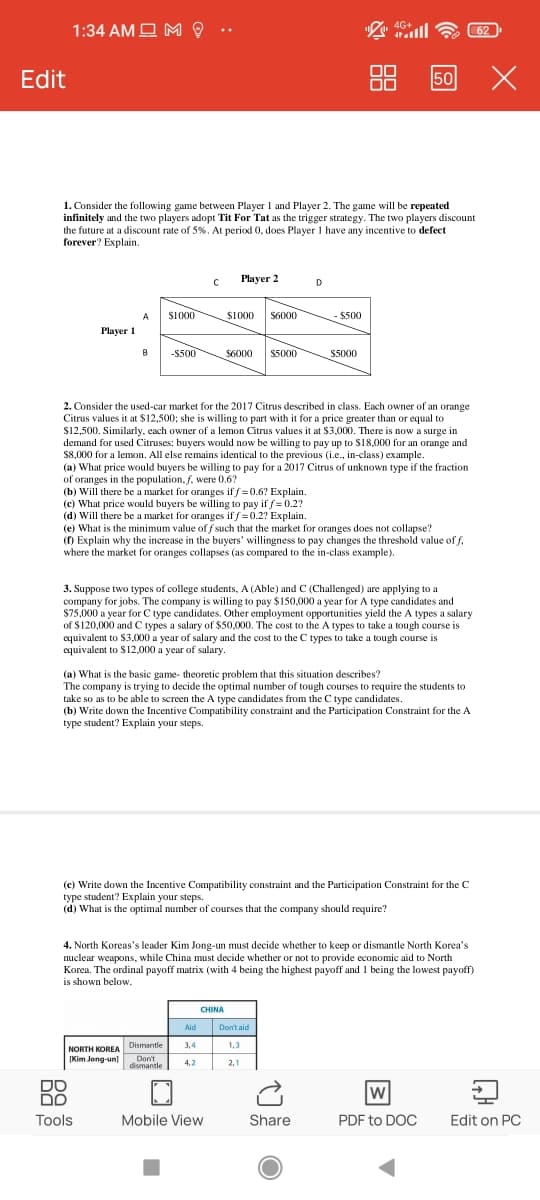1. Consider the following game between Player I and Player 2. The game will be repeated infinitely and the two players adopt Tit For Tat as the trigger strategy. The two players discount the future at a discount rate of 5%. At period 0, does Player I have any incentive to defect forever? Explain. c Player 2 A S1000 $1000 S6000 $500 Player 1 B -S500 $6000 S5000 $5000
1. Consider the following game between Player I and Player 2. The game will be repeated infinitely and the two players adopt Tit For Tat as the trigger strategy. The two players discount the future at a discount rate of 5%. At period 0, does Player I have any incentive to defect forever? Explain. c Player 2 A S1000 $1000 S6000 $500 Player 1 B -S500 $6000 S5000 $5000
Chapter7: Uncertainty
Section: Chapter Questions
Problem 7.7P
Related questions
Question
Please try to solve it complete in 2 hours

Transcribed Image Text:1:34 AM O M O ..
4G+
62
Edit
50
1. Consider the following game between Player I and Player 2. The game will be repeated
infinitely and the two players adopt Tit For Tat as the trigger strategy. The two players discount
the future at a discount rate of 5%. At period 0, does Player 1 have any incentive to defect
forever? Explain.
Player 2
D
A
$1000
$1000
$6000
$500
Player 1
-$500
$6000
$5000
$5000
2. Consider the used-car market for the 2017 Citrus described in class. Each owner of an orange
Citrus values it at $12,500; she is willing to part with it for a price greater than or equal to
$12,500. Similarly, cach owner of a lemon Citrus values it at $3,000. There is now a surge in
demand for used Citruses: buyers would now be willing to pay up to $18,000 for an orange and
$8,000 for a lemon. All else remains identical to the previous (i.e., in-class) example.
(a) What price would buyers be willing to pay for a 2017 Citrus of unknown type if the fraction
of oranges in the population, f. were 0.6?
(b) Will there be a market for oranges if f=0.6? Explain.
(c) What price would buyers be willing to pay if f= 0.2?
(d) Will there be a market for oranges if f=0.2? Explain.
(e) What is the minimum value of f such that the market for oranges does not collapse?
(1) Explain why the increase in the buyers' willingness to pay changes the threshold value of f.
where the market for oranges collapses (as compared to the in-class example).
3. Suppose two types of college students, A (Able) and C (Challenged) are applying to a
company for jobs. The company is willing to pay $150,000 a year for A type candidates and
$75,000 a year for C type candidates. Other employment opportunities yield the A types a salary
of $120,000 and C types a salary of $50,000. The cost to the A types to take a tough course is
equivalent to $3,000 a year of salary and the cost to the C types to take a tough course is
equivalent to $12,000 a year of salary.
(a) What is the basic game- theoretic problem that this situation describes?
The company is trying to decide the optimal number of tough courses to require the students to
take so as to be able to screen the A type candidates from the C type candidates.
(b) Write down the Incentive Compatibility constraint and the Participation Constraint for the A
type student? Explain your steps.
(c) Write down the Incentive Compatibility constraint and the Participation Constraint for the C
type student? Explain your steps.
(d) What is the optimal number of courses that the company should require?
4. North Koreas's leader Kim Jong-un must decide whether to keep or dismantle North Korea's
nuclear weapons, while China must decide whether or not to provide economic aid to North
Korea. The ordinal payoff matrix (with 4 being the highest payoff and 1 being the lowest payoff)
is shown below.
CHINA
Aid
Don't aid
Dismantle
3,4
1,3
NORTH KOREA
[Kim Jong-un
Don't
dismantle
4,2
2,1
DD
DO
Tools
Mobile View
Share
PDF to DOC
Edit on PC
Expert Solution
This question has been solved!
Explore an expertly crafted, step-by-step solution for a thorough understanding of key concepts.
Step by step
Solved in 3 steps with 1 images

Knowledge Booster
Learn more about
Need a deep-dive on the concept behind this application? Look no further. Learn more about this topic, economics and related others by exploring similar questions and additional content below.Recommended textbooks for you

